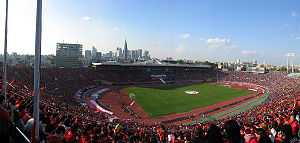National Olympic Stadium (Tokyo)
| Kokuritsu Kyōgijō | |
 | |
| Location | 10-2, Kasumigaoka-machi, Shinjuku, Tokyo, Japan |
|---|---|
| Owner | Japan Sport Council |
| Capacity |
48,000 (seated) 57,363 |
| Record attendance | 80,000 (L'Arc-en-Ciel, 21–22 March 2014) |
| Field size | 105 × 68 m |
| Surface | Grass |
| Construction | |
| Opened | 1958 |
| Closed | 2014 |
| Construction cost | 1 billion USD (2019 reconstruction) |
| Architect | Mitsuo Katayama |
| Tenants | |
|
1958 Asian Games 1964 Summer Olympics 1980–2001 Intercontinental Cup 1991 World Championships in Athletics 1976–1993 Coca-Cola Classic 1967-Present Emperor Cup (finals venue) Japanese Super Cup 2019 Rugby World Cup 2020 Summer Olympics 2020 Summer Paralympics | |
National Stadium (国立霞ヶ丘陸上競技場 Kokuritsu Kasumigaoka Rikujō Kyogijō) was a stadium in Kasumigaoka, Shinjuku, Tokyo, Japan. The stadium served as the main stadium for the opening and closing ceremonies, as well as being the venue for track and field events at the 1964 Summer Olympic Games. The Japan national football team's home matches and major football club cup finals were held at the stadium. The stadium's official capacity was 57,363, but the real capacity was only 48,000 seats.
The stadium is under demolition as of 2015. The site will be redeveloped with a new larger-capacity National Olympic Stadium designed by architect Zaha Hadid.[1] The new stadium is set to be the main venue for the 2020 Summer Olympics and Paralympic Games, as well as the 2019 Rugby World Cup.
History
The stadium was completed in 1958 as the Japanese National Stadium on the site of the former Meiji Shrine Outer Park Stadium. Its first major event was the 1958 Asian Games.
The venue was unscathed by the 2011 Tōhoku earthquake and tsunami. Yasuhiro Nakamori, international relations director for the Japanese Olympic Committee, told Around the Rings he attributed the lack of damage to Japan's stringent building codes.[2]
Redevelopment
After Tokyo submitted their bid for the 2020 Summer Olympics, there was talk of possibly renovating or reconstructing the National Olympic Stadium. The stadium would host the opening and closing ceremonies as well as track and field events.[3]
It was confirmed in February 2012 that the stadium would be reconstructed and redeveloped, and receive a $1 billion upgrade. In November 2012, renderings of the new national stadium were revealed. The new national stadium will be built to a design by architect Zaha Hadid. It is planned that the existing stadium is to be demolished in 2015 and the new one completed in March 2019.[4] The new stadium will be the Tokyo 2020 venue for athletics, rugby and certain football finals, as well as the opening and closing ceremonies.[5] It will also be the main venue for the 2019 Rugby World Cup.
Events
In addition to the 1964 Summer Olympics, the stadium held many other significant events, most notably the 1991 World Athletics Championships, the Mirage Bowl games from 1976–1993, and the Intercontinental Cup (Toyota Cup) from 1980–2001. As the National Stadium of Japan, the Japan national football team held home games at the venue, which also hosted the final game of the Emperor's Cup on New Year's Day, and the J. League Cup in November, as well as the Fuji Xerox Cup in the end of February or early March, every year. It was also the venue, every year in early January, for the semifinals and final of the All Japan High School Soccer Tournament, which is commonly known as Winter Kokuritsu.
Rugby games were also played at this venue, including the annual university rugby semi-finals and finals, as the nearby Chichibunomiya Rugby Stadium's capacity is insufficient for the number of student fans the event attracts.
As of 2014, many groups have held concerts at the National Stadium. By order of appearance they are: SMAP, Dreams Come True, Arashi,[6] L'Arc-en-Ciel,[7][8] Momoiro Clover Z, and AKB48.
With pending renovations to prepare the stadium for the 2020 Olympics, a special farewell concert "Sayonara National Olympic Stadium Final Week Japan Night" consisting of 13 acts was held on May 28 and 29.[9] Artists performing on the 28th ("Yell for Japan") included Ikimono-gakari, Ukasukajī(Kazutoshi Sakurai & GAKU-MC), Kaori Kishitani, The Gospellers, Kazuyoshi Saito, Sukima Switch, Naoto Inti Raymi, Funky Kato and Yuzu; artists performing on the 29th ("JAPAN to the World") included SEKAI NO OWARI, Perfume, Man with a Mission and L'Arc〜en〜Ciel.
Access
Access to the stadium was from Sendagaya or Shinanomachi stations along the JR Chūō-Sōbu Line; from Kokuritsu Kyogijo Station on the Toei Oedo Line; and from Gaienmae Station on the Tokyo Metro Ginza Line.
References
- ↑ "New National Stadium - Tokyo, Japan". Zaha Hadid Architects. Retrieved 11 March 2014.
- ↑
- ↑ http://www.gamesbids.com/eng/olympic_bids/2020_bid_news/1216135899.html
- ↑ Dazzling re-design for 2019 World Cup final venue
- ↑ "Venue Plan". Tokyo 2020 Bid Committee. Retrieved 8 July 2013.
- ↑ "Arashi celebrates 10 years with best album, tour". Tokyograph. 2009-06-25. Retrieved 2010-04-11.
- ↑
- ↑ "L'Arc-en-Ciel国立初日であの曲の"リベンジ"果たす". Natalie. 2012-05-28.
- ↑ "SAYONARA NATIONAL OLYMPIC STADIUM FINAL WEEK "JAPAN NIGHT"". ANIME FESTIVAL ASIA. 2014-04-17.
- 1964 Summer Olympics official report. Volume 1. Part 1. pp. 118–20.
External links
| Wikimedia Commons has media related to Olympic Stadium (Tokyo). |
- Official website (Japanese)
- Satellite photo of the stadium from Google Maps
- Stadiums in Japan:Tokyo National Stadium
- National Stadium
- National Stadium, Tokyo
| Preceded by Stadio Olimpico Rome |
Summer Olympics Opening and Closing Ceremonies (National Stadium) 1964 |
Succeeded by Estadio Olímpico Universitario Mexico City |
| Preceded by Stadio Olimpico Rome |
Olympic Athletics competitions Main Venue 1964 |
Succeeded by Estadio Olímpico Universitario Mexico City |
| Preceded by Stadio Flaminio Rome |
Summer Olympics Football Men's Finals (National Stadium) 1964 |
Succeeded by Estadio Azteca Mexico City |
| Preceded by Two-legged finals |
Intercontinental Cup Final Venue 1980–2001 |
Succeeded by International Stadium Yokohama Yokohama |
| Preceded by Vacant ( Two-legged finals ) |
AFC Champions League Final Venue 2009, 2010 |
Succeeded by Jeonju World Cup Stadium |
| Preceded by Estádio do Maracanã Rio de Janeiro |
Summer Olympics Opening and Closing Ceremonies (National Stadium) 2020 |
Succeeded by TBA |
| ||||||
| ||||||
| ||||||||||||||||||
| ||||||||
| ||||||||
| ||||||||
| ||||||
| ||||||
Coordinates: 35°40′41″N 139°42′53″E / 35.67806°N 139.71472°E


